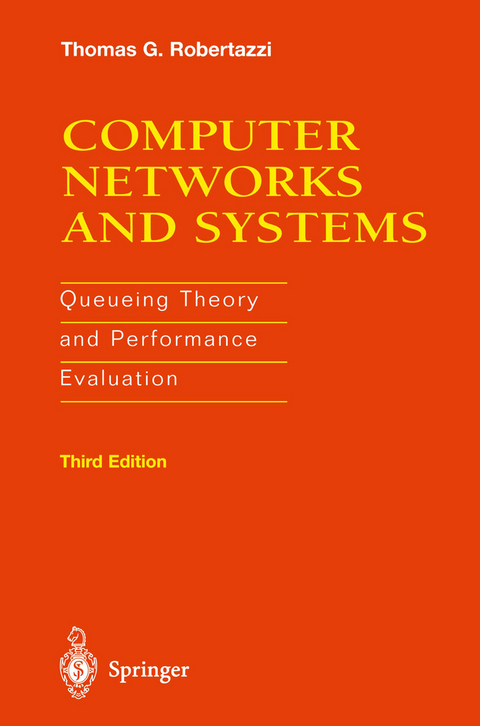
Computer Networks and Systems
Springer-Verlag New York Inc.
978-0-387-95037-2 (ISBN)
1: The Queueing Paradigm.- 1.1 Introduction.- 1.2 Queueing Theory.- 1.3 Queueing Models.- 1.4 Case Study I: Performance Model of a Distributed File Service By W.G. Nichols and J.S. Emer.- 1.5 Case Study II: Single-bus Multiprocessor Modeling By B.L. Bodnar and A.C. Liu.- 1.6 Case Study III: TeraNet, A Lightwave Network.- 1.7 Case Study IV: Performance Model of a Shared Medium Packet Switch By R. Guerin.- 2: Single Queueing Systems.- 2.1 Introduction.- 2.2 The M/M/1 Queueing System.- 2.3 Little’s Law.- 2.4 Reversibility and Burke’s Theorem.- 2.5 The State Dependent M/M/1 Queueing System.- 2.6 The M/M/1/N Queueing System: The Finite Buffer Case.- 2.7 The M/M/? Queueing System: Infinite Number of Servers.- 2.8 The M/M/m Queueing System: m Parallel Servers with a Queue.- 2.9 The M/M/m/m Queue: A Loss System.- 2.10 Central Server CPU Model.- 2.11 Transient Solution of the M/M/1/? Queueing System.- 2.12 The M/G/1 Queueing System.- 2.13 Priority Systems for Multiclass Traffic.- To Look Further.- Problems.- 3: Networks of Queues.- 3.1 Introduction.- 3.2 The Product Form Solution.- 3.3 Algebraic Topological Interpretation of the Product Form Solution.- 3.4 Recursive Solution of Nonproduct Form Networks.- 3.5 Queueing Networks with Negative Customers.- To Look Further.- Problems.- 4: Numerical Solution of Models.- 4.1 Introduction.- 4.2 Closed Queueing Networks: Convolution Algorithm.- 4.3 Mean Value Analysis.- 4.4 PANACEA: Approach for Large Markovian Queueing Networks.- 4.5 Norton’s Equivalent for Queueing Networks.- 4.6 Simulation of Communication Networks By J.F. Kurose and H.T. Mouftah.- To Look Further.- Problems.- 5: Stochastic Petri Nets.- 5.1 Introduction.- 5.2 Bus-oriented Multiprocessor Model.- 5.3 Toroidal MPN Lattices.- 5.4 The Dining Philosophers Problem.-5.5 A Station-oriented CSMA/CD Protocol Model.- 5.6 The Alternating Bit Protocol.- 5.7 SPN’s without Product Form Solutions.- 5.8 Conclusion.- To Look Further.- Problems.- 6: Discrete Time Queueing Systems.- 6.1 Introduction.- 6.2 Discrete Time Queueing Systems.- 6.3 Discrete Time Arrival Processes.- 6.4 The Geom/Geom/m/N Queueing System.- 6.5 The Geom/Geom/1/N and Geom/Geom/1 Queueing Systems.- 6.6 Case Study I: Queueing on a Space Division Packet Switch.- 6.7 Case Study II: Queueing on a Single-buffered Banyan Network.- 6.8 Case Study III: DQDB Erasure Station Location.- To Look Further.- Problems.- 7: Network Traffic Modeling.- 7.1 Introduction.- 7.2 Continuous Time Models.- 7.3 Discrete Time Models.- 7.4 Solution Methods.- 7.5 Burstiness.- 7.6 Self-Similar Traffic.- To Look Further.- Appendix: Probability Theory Review.- A.1 Probability.- A.2 Densities and Distribution Functions.- A.3 Joint Densities and Distributions.- A.4 Expectations.- A.5 Convolution.- A.6 Combinatorics.- A.7 Some Useful Summations.- A.8 Useful Moment-generating Function Identities.- References.
| Zusatzinfo | XIII, 409 p. |
|---|---|
| Verlagsort | New York, NY |
| Sprache | englisch |
| Maße | 155 x 235 mm |
| Themenwelt | Mathematik / Informatik ► Informatik ► Netzwerke |
| Mathematik / Informatik ► Mathematik ► Wahrscheinlichkeit / Kombinatorik | |
| ISBN-10 | 0-387-95037-0 / 0387950370 |
| ISBN-13 | 978-0-387-95037-2 / 9780387950372 |
| Zustand | Neuware |
| Haben Sie eine Frage zum Produkt? |
aus dem Bereich


